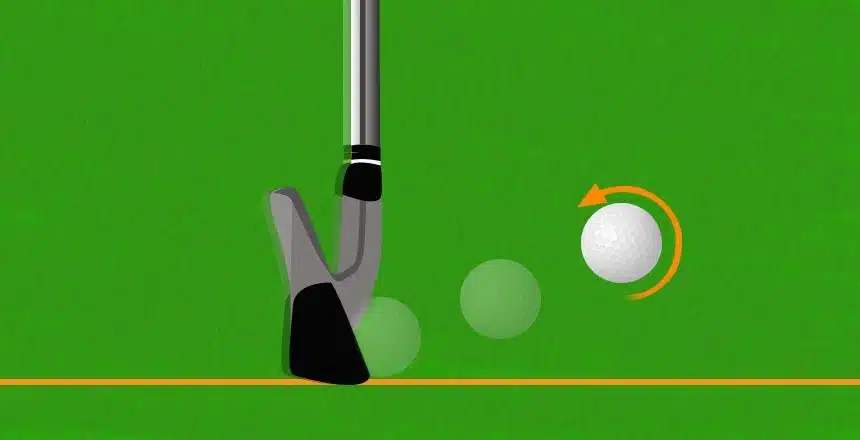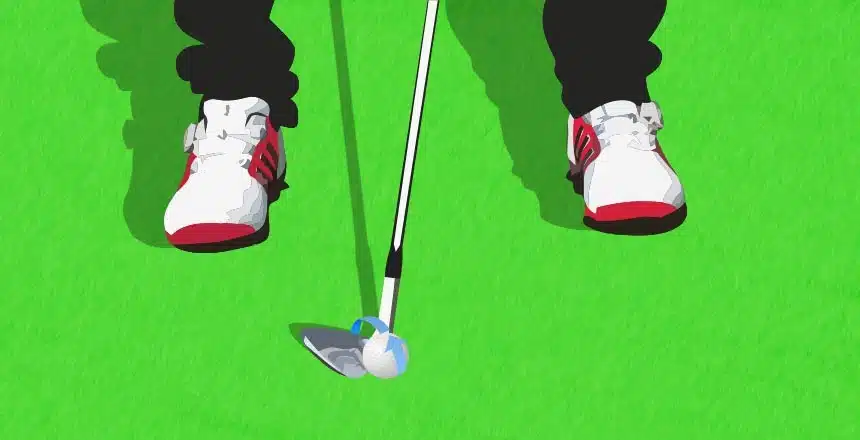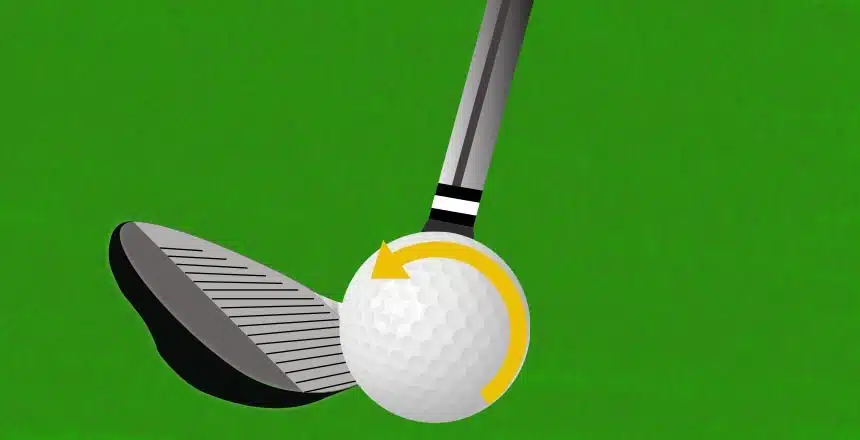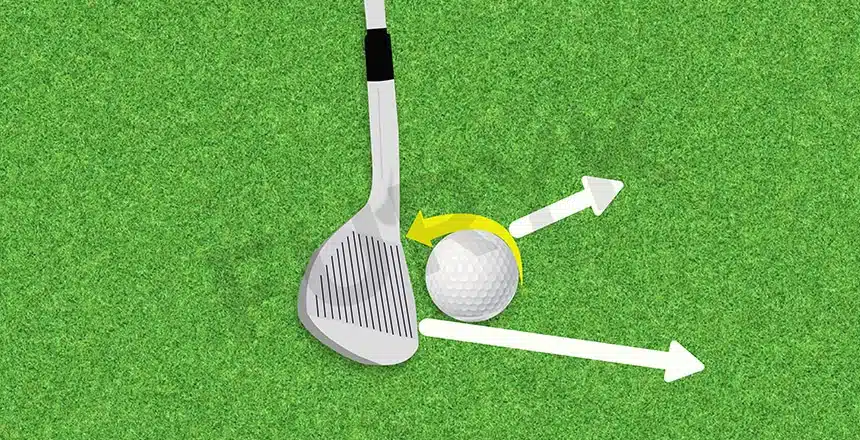Backspin is a natural, effortless part of a decent shot with your driver, woods, and irons. Backspin is customarily generated when your strikes are reasonably good. But here’s the thing about backspin, golfers, when they mention backspin, are more concerned with the ball landing and then spinning in the backward direction. This is referred to as the ‘spin rate’ of the golf ball.
In this article, I’m going to talk at length about what it all means, what causes backspin, and, most importantly, how to increase backspin. Putting more backspin on your golf ball is actually a 3-factor formula, and I’m obviously going to cover that as well.
So let’s get on with it and upgrade our golfing game and performance!
In This Post
- What Does Backspin Mean In Golf?
- So Why Do You Really Need Backspin?
- How to Put Spin On A Golf Ball – The 3-Factor Formula!
- How to Get More Backspin (5 Quick, Effective Ways to Increase Spin!)
- 5 Most Effective Golf Backspin Drills
- Additional Tips to Put More Backspin On A Golf Ball
- What Causes Backspin On A Golf Ball?
- How to Put Backspin On A Golf Ball With An Iron – More Backspin On Irons!
- How to Put Backspin On Your Chip Shots?
- Some Final Words of Conclusion…
What Does Backspin Mean In Golf?
Be it the most expensive golf balls or the cheapest ones, they ALL have dimples. And what this dimple pattern does is get the ball airborne. Meaning dimples create lift. Not just that, they react to the golf club’s grooves, when contact is made, by also producing spin.
So what is backspin? It’s when the ball rotates or spins backward in flight.

Now someone new to the game might think that since the golf ball is rotating backward, this means it’s going to cover a shorter distance. Wrong! When there’s too much backspin, the ball, on the contrary, actually flies farther.
But then not every golf shot has that kind of backspin, only a good or decent strike is capable of generating distance-boosting backspin. And your swing speed determines this. For example, those with a slower swing speed, by default, produce a lower spin rate. Nonetheless, some backspin is automatically created, particularly in the short game.
So Why Do You Really Need Backspin?
Why is backspin so important in the game of golf? I have two words for you – ‘lift’ and ‘control’.
As is made obvious from the description of backspin in the section above, backspin helps in producing lift to make the golf ball fly farther. When the ball is airborne, meaning in flight, the dimples generate lift. And that, in turn, carries your shot higher as well as farther.
On the other hand, if there’s not sufficient backspin, then the dimples fail to create much lift. As a result, the golf ball doesn’t travel as long. But with enough spin, you can also get the ball to go right or left, thus changing its direction even.
And then we have the control factor that too is decided by backspin. Backspin helps in controlling the golf ball upon landing, which matters a lot in the short game whenever you want your shots to stop quickly. So with a good amount of spin, you can actually hit the ball on that green with confidence that it will stay right where it lands. This means you gain the upper hand in terms of accuracy and precision.
Now let me tell you what will happen if you don’t have that much-needed spin. The golf ball either lands on the green or it lands short and rolls up to that green. In the case of the latter then, the chances of your shot going off-target or hitting a bump are likely. While in the case of the former, the ball rolls over the back of the green. Both situations, no doubt, are equally frustrating.
How to Put Spin On A Golf Ball – The 3-Factor Formula!

1. Clubhead Speed
The norm is that the greater the clubhead speed, the higher the backspin. With that logic in place, generating enough speed on chip shots at only a 20-yard distance from that green is not possible, hence no need for spin.
On the other hand, only a true wedge shot (till 7-iron) can afford you the appropriate distance. At such times then, your goal is to either maintain or increase the clubhead speed. Because if that speed is depleted, the golf ball will inevitably ride up the face of the club and lose its grip, thus no spin produced.
2. Spin Loft
If you wish to maximize spin, you don’t want to sweep the golf ball cleanly and smoothly off the ground. Rather hitting down on that ball is the right strategy. Make sure the golf ball is placed farther back than usual in the stance position and then hit into it before your club touches the turf. And don’t forget to follow through with a divot, if that’s possible for you.
This approach, in short, is known as a steeper angle of attack in golf. It combines with the club’s angle to create spin loft. When you hit down while either maintaining or boosting speed, the golf ball compresses optimally to generate the required spin effect.
3. Friction
And now it all comes down to friction, which is handled by the clubface grooves AND how solidly you strike the golf ball.
Let’s talk about the grooves. These ought to be sharp and clear, even if your golf club is a bit worn out. So make sure you give your clubs a thorough cleaning to get rid of grass, dirt, etc. At the same time, your golf balls should also be clean and dry.
Speaking of which, there are soft-core and hard-core golf balls. The softer kind (mostly, these are beginner-friendly golf balls) is more suitable when it comes to giving rise to greater spin as well as a better feel on its own.
Therefore, the moral of the story here in terms of friction is that no grass or moisture must be present between the clubface and ball. This explains why you don’t achieve optimal spin when you play from rough or when the weather conditions are damp or rainy.
How to Get More Backspin (5 Quick, Effective Ways to Increase Spin!)
Steeper Angle of Attack
The angle or line of attack the clubhead uses for making contact with the ball should be more vertical i.e. steeper for getting more spin more easily.
Faster Swing Speed
The faster you swing, the greater the spin on the golf ball leaving the clubface. That’s the kind of effect swing speed has on backspin.
But then don’t force a faster swing speed, meaning don’t make the rookie mistake of swinging hard instead of fast. So if you have a slower swing speed, then you should be choosing lightweight golf clubs with a more flexible shaft because these automatically and very naturally promote a faster swing speed to initiate more spin.
Square Clubface At Impact
Where the clubface is pointing (open or closed) at the time of contact/impact plays a huge role as far as producing side spin is concerned. And when there’s sidespin, there’s obviously no backspin. So to get the golf ball to spin backward (and to avoid putting sidespin on the ball), square the clubface at impact.
Higher Loft
What is your golf club loft angle? Because a higher loft does more than just make that particular club less challenging to hit. It also increases golf ball spin. That is why your 9-iron, since it has a higher loft, is so much easier to hit than your lower-lofted 4-iron.
Shorter Grass
Remember we talked about there being no friction in the form of grass between the clubface and ball at the time of impact? So by applying the same logic here, we come to the conclusion that shorter grass, that is fairway grass, leads to a more solid strike that creates more spin.
Rough, on the other hand, consists of longer grass, which is not the most ideal for spinning the golf ball.
5 Most Effective Golf Backspin Drills
1. Tee Drill
This is the most effective and simplest drill to increase backspin and it requires you to have some extra tees at your disposal.
- When on that driving range, place one tee around half an inch ahead of the ball. Make sure the tee is pushed completely into the turf, you should only be able to view its top.
- Repeat the same with another tee but place this right outside the golf ball.
- Now, with your swing, break that first tee using your golf club.
- The divot produced should begin at the point of the second, outside tee, and then continue forward around 5 inches but don’t go deeper than 1 inch.
Now, what are the benefits of this Tee Drill?
You’re able to get that spin-boosting downward angle of attack and you end up hitting the ball and not the ground first (since the divot begins not before but after the golf ball).
2. Impact Bag Drill
You need a golf impact bag for this drill but no balls.
- Take a few golf swings on that impact bag.
- When hitting, concentrate more on the angle of the clubface at impact.
- Practice till you’re able to hit the impact bag consistently keeping the clubface square.
When you can square the clubface at impact (hence, it means you’ve quit constantly leaving the clubface slightly closed or open), the golf ball comes off straight with more backspin.
3. Weighted Golf Club Drill
When your practice sessions consist of swinging a more weighted or heavier club, you develop a ‘feel’ and greater muscle strength for it. So at the time of actually swinging your lighter, real golf club, you naturally swing faster. And when your swing speed increases, so does the backspin rate.
4. Alignment Stick Drill
You obviously need one of those alignment sticks that come in handy when improving your golf swing path.
Grip the alignment stick and your club together. The stick should be placed under the left arm. And what it does is make sure that you don’t flip your wrists when hitting chip or pitch shots. Each time you try to lift that ball or flick your wrists through impact, the alignment stick gets in the way, so you can’t complete your shot.
5. Front Foot Drill
If your back foot is supporting all of your weight when you’re hitting chip shots, which means you’re hitting the golf ball up and not hitting down, then no wonder the golf ball isn’t spinning backward. Instead, practice this Front Foot Drill.
Place the most part of your body weight on your left foot. And maintain that when hitting chip shots to gain more backspin more easily. Many golfers use this Front Foot Drill to chip backward-spinning shorter shots.
Additional Tips to Put More Backspin On A Golf Ball
Here are some extra tips you might want to know for increasing backspin the most easily…
Golf balls have a compression rating, right? And when this rating of compression is 90, which is mid-range, you get a good level of backspin. According to that logic, a higher compression rating (100 and above) produces the least amount of backspin.
Likewise, soft-cover golf balls create more spin since they grip club grooves better than their hard-cover counterparts. But then soft covers are more likely to get damaged by abrasions and cuts.
Then we move on to golf irons for imparting impressive backspin. Do not expect much spin out of your 3-iron. The longest club to use, in this context then, is the 7-iron because from your 6-iron onwards, you do not get the much-needed spin loft.
The logic here is plain and simple that to generate the desired spin effect, what matters is height and not distance. This means a higher loft will give you more spin on the golf ball more easily.
And then we have the backswing, which you have to adjust in order to increase backspin. Meaning the angle of attack should be steeper (more upright position of the golf club at impact), so the club hits the ball first before making contact with the ground. This inevitably increases golf ball compression (optimal compression for an optimal spin effect), and do remember to follow through with a small divot.
What NOT TO DO for Increasing Backspin
- When playing downwind, don’t focus on producing more backspin as that is most likely to overshoot greens. Instead, play your shots into headwind since it helps with elevation and height.
- For the very same reason as above, don’t play backspin when the green isn’t sloping toward you (meaning when it’s sloping away).
- Don’t expect to create the desired spin effect if the green is too hard. Only when the greens are soft enough for the golf ball to bite/grip can there be enough spin.
What Causes Backspin On A Golf Ball?
The following factors indeed greatly influence your golf ball backspin…
Surface Friction
When the turf is smoother (shorter grass on the fairway), the backspin is greater due to less friction. On the contrary, rougher surfaces and longer grass produce more friction and reduce spin rate.
Clubhead Speed
Decreased clubhead speed gives you a lower backspin. So if you aim to put more backspin on your golf ball, then try to boost your clubhead speed.
Golf Club Loft
You’ll see that higher lofted golf clubs, like wedges, automatically create greater backspin. Because with a higher loft, the angle of attack is ideal for instinctively increasing spin rate.
Golf Ball Construction
Do hard-cover or soft-cover golf balls spin more? Softer balls spin much more in comparison to hard balls.
Much like the softer cover, even a lower compression rating of a golf ball increases its spin rate. That is why Titleist Pro V1 from this list of the best golf balls for seniors is such a popular choice for maximizing backspin along with delivering super-long distances off the tee.
How to Put Backspin On A Golf Ball With An Iron – More Backspin On Irons!
Almost every golfer knows that iron shots off that fairway are so much more challenging to hit than off-the-tee shots. Even the tiniest blunder in your swing can lead to thin or fat strikes when the golf ball is placed on the turf.
So to overcome this very small margin of error, you have to know how to produce a consistent, solid strike.
Step 1 – Adjust the Golf Ball Position
The ball should be placed in the center of your stance for irons shots. If the lie is tighter on the fairway, then position the golf ball even further off your back foot. You can first try keeping it right off that back foot to see how easy the ball is for hitting down on and then taking a divot.
But whatever you do, refrain from hitting the golf ball high if you want your iron shot to be crisp and clean.
The ball placed back in your stance encourages a more natural downward blow since it’s positioned just behind the lowest station of your swing arc. And that perfect downward blow means more backspin.
Step 2 – Transfer Your Weight Into Your Left Foot
Weight transference is the next most crucial part of the process when putting greater backspin on your iron shots.
Scooping the golf ball high into the air, as opposed to hitting down on the ball, gets your weight stuck on your back foot. But when you hit down for generating more backspin, you automatically move your swing arc forward. This means that your weight, by default, is transferred forward into your left foot.
A simpler way to go about this would be to just ensure that your right foot gets into the “traditional” finish position, which will naturally shift your weight into the front, left foot. And this is certainly going to add more backspin AND control to your iron shots.
How to Put Backspin On Your Chip Shots?

Are You Using the Right Equipment?
If you want the golf ball to spin, then it better be the right type of ball. And the same applies to the golf club you use.
So what is the right golf club here for your chip shots? A higher lofted wedge, which would be the 60-degree wedge (it’s the most highly recommended for chip shots that really SPIN). Your next best alternative is a 58-degree or 56-degree wedge, but nothing lower because then you won’t get enough spin loft effect.
As for which is the right ball, these are soft-cover golf balls that produce a decent spin rate as opposed to hard covers that just don’t spin like that at all.
Is Your Setup Correct?
Moving on to a backspin-promoting setup for your chip shots, the three most significant factors that matter are golf ball position, club shaft position, and weight distribution in the stance.
- You want to hit down on the ball, right? Normally, for chipping, the ball is placed behind the stance. But when your goal is to hit your chip shots in a way that they stop quickly because of spin, you need to position the golf ball in the center of the stance. This way, during impact, you hit under that ball and this is how it produces the required spin.
- And now, what about your golf club shaft positioning because this plays an important role too? After all, it does promote loft. Even though common for chip shots, don’t lean the club shaft forward before you begin your swing. If you do that, the loft will get compromised, which means a low, running golf ball.
Instead, keep your hands over that ball directly (do not push them forward, no matter how tempting it is to do so). Only then does a vertical shaft setup take form, and then this you can easily mimic during impact.
- Moving on to your weight distribution in the stance. For hitting down slightly, it’s a must to lean toward your target at impact. So place the majority of your body weight on the left foot (if you’re right-handed of course) during address. This will surely result in a downward strike, cleaner contact, thus more backspin.
How Fast/Aggressive Is Your Golf Swing?
Maximum swing speed through impact definitely helps in putting more backspin. But then does this necessarily mean that you have to produce a more aggressive swing than you’re normally comfortable with?
The whole aim here is for you to get the golf ball closest to the hole right before the spin effect ceases and brings the ball to a halt. So for this, an even greater speed is needed since the run out will be little once that golf ball hits that ground.
So by swinging fast, what is meant is to brush your club under that ball over the grass while also making sure that you’re accelerating speed through your swing.
Some Final Words of Conclusion…
Enough has been discussed for you to believe that now you know what it takes to finally put a decent level of backspin on your shots. So grab those golf clubs of yours and it’s time to practice as much as you can with them to increase that distance-boosting backspin!
But backspin is the most important for shots struck around the green. Being that far away from the hole means knowing how to stop the golf ball right away with the perfect spin rate. Because factors like backspin, especially a higher spin rate, surely work in your favor when it comes to improving your golf game and scores.

